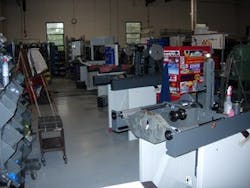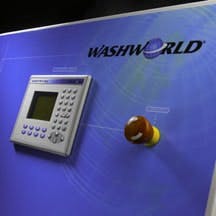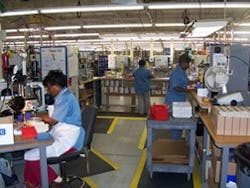Far from a machine-building giant, Sunnen is proof that lean isn’t just for billion-dollar multinational OEMs. And its effects reach far up the value stream to where the controls engineers paddle.
Sunnen’s lean approach also forces controls engineers to be more aware of the structure of the bill of materials and the effect it has on manufacturing flow. “We’ve done quite a bit of work on flattening the bill of materials, which, coupled with the standardization of design and components, allows us to have more flexibility in responding to mix changes,” says Broyles.
But that transformation didn’t happen overnight at Sunnen. Almost a year after lean initiatives were implemented, Sunnen’s first new unit reorganized around a value stream was operating in future state mode (Figure 1).
Future state maps were used to create a new machine final assembly area with significantly reduced muda.
Source: Sunnen Products.
“We previously built machines in batches of 10,” explains Broyles. “Now, we operate in one-piece flow for the machine builds. Sunnen has 13 manufacturing value streams, each with its own profit-and-loss statement. Currently, three of them have implemented the first future state map and are in continuous improvement mode. Several others are in the process of implementing the future state vision, and a few others are now in the midst of the mapping process. All value streams are scheduled to be completed by the end of 2008.”
Impressive? It is, if you understand what Broyles is talking about.
Lean manufacturing is based on the Toyota Production System, a manufacturing process developed to remove waste, focus production flow and improve customer value.
In their book, Lean Thinking, Jim Womack, founder and chairman of Lean Enterprise Institute in Cambridge, Mass., and Dan Jones, president of Lean Enterprise Academy in Ross-on-Wye, U.K., define lean organizations through five distinguishing principles—value specification, value stream identification, flow, customer pull and the pursuit of perfection.
First, companies specify value in a product that meets a customer’s needs at a specific price at a specific time. Then, the product’s value stream is identified by mapping all actions required to bring it from either concept or order-taking to delivery. Non-value steps are identified in present state maps and eliminated in future state maps. Once the value stream is mapped, parts are manufactured one at a time and flow through production based on customer orders, rather than traditional batch-and-queue assembly. Instead of scheduling based on sales forecasts, customer orders actually pull products through the process so nothing is produced upstream before a customer asks for it. Finally, the first four steps constantly are scrutinized and reevaluated as part of a continuous improvement process.
The ability to reduce batch size—critical to one-piece flow—is dependent on reducing setup times. The shorter the changeover time, the more setups can be completed.
“Lean really helped us look at product lines as a whole and work on improving the flow through the overall value stream, versus working on specific areas like setup reduction across the board,” says Broyles. “We now would find the process that would have the largest interval—the largest lot size based on setup—and improve the setup on that process.”
Up the CreekAs a machine is traced upstream, it ultimately starts with the vendors’ components. And eliminating waste by reducing inventory begins before the first parts are even built. “Vendor-managed inventory has been implemented with many of our key suppliers,” explains Jeff Martin, director of operations at Washworld, builder of high-velocity vehicle wash systems in DePere, Wis. “In many cases, inventory now is delivered directly to the point of assembly. It is much more efficient, and provided a means for us to be more responsive to customer needs. We’ve been able to support and handle a significant growth in sales while at the same time increase inventory turns. Lower inventory has sped up the design process by allowing design releases to be phased into production faster.”
Because Washworld offers 24/7 service of its machines in 11 countries, replacement parts play a key role in its after-sales support.
“Our spare-parts support has improved significantly,” adds Martin. “Before implementing lean in our parts department, inventory levels and replenishment triggers were not in sync. In many cases, our suppliers are monitoring the inventory levels for us and stocking the shelves.” For parts that can’t be managed by vendors, Washworld implemented a kanban system. Kanban is a Japanese word, a surviving reminder of the Toyota Production System, that means “billboard.” It’s a signal that indicates inventory is low or nonexistent and needs to be replenished. “In addition to addressing inventory shortages, the kanban system lowered our inventory in many cases,” claims Martin.
Suppliers have helped Washworld in more ways than just improving inventory turns. Martin says research and development, engineering support, reaction to customer needs, production flexibility and development of HMI (Figure 2) all have improved through the help of vendors.
HMI gives car wash operators troubleshooting information, including the controller’s inputs and outputs, as well as detailed data on the status and history of any malfunctions.
Source: Washworld.
For example, Washworld worked with one supplier to design a standard control panel that could be modified to meet a customer’s specific needs. “This standard control panel allows us to more quickly build the car wash systems, as well as accommodate changes in voltage requirements and other unique attributes that vary by country and customer,” explains Martin. “Once installed, the control panel’s remote diagnostics, online real-time troubleshooting capabilities and distributor support help keep machines up and running, to reduce downtime.” Standardization simplified Washworld’s manufacturing process and reduced engineering and configuration costs, he says.
That’s Using Your HeadwatersThe design stage is critical to any machine-building endeavor, and lean’s advantages are many at this phase, according to Paul Wenner, district OEM manager at Rockwell Automation. Like Washworld, other machine builders can turn upstream to their suppliers for more than inventory; often, vendors can aid in thinking through the lean process.
“Lean is all about efficiencies,” he explains. “For most engineering design departments, when doing a particular project there is a tendency for the engineers to either over-design or under-design it. Lean drives out a process or requirements document. What contributes to a lean initiative in the design group is that they have to sit down and really develop the standards and methodologies that take in account all facets of the business, not just for one group. I preach and emphasize using a methodology for designing in states—a design state for the feed or infeed, a design state for the product manipulation area and a design state for the outfeed. Let’s develop a system so that everybody who touches it sees the same thing.”
One OEM, as an example, has begun to use Six Sigma practices to manage the data for what they need to do in design, explains Wenner. Six Sigma process improvement, a kindred spirit to lean principles, aims to eliminate errors by reducing variation in the process. This particular company is building more diagnostic data into its machines. “They’re looking at that data, identifying errors and then systematically eliminating those machine design errors in the next iteration machine,” says Wenner. “This is a machine in production, and the data derived almost turns into a reasonable bell curve. They’re designing out those types of errors they’ve been seeing. In respect to lean, those initiatives really need a combination of good data and engineering commitment in order to achieve true excellence in design practices and processes. For example, a lot of engineers will do some very creative designs when it comes to product manipulation or handling, but with a lean approach the engineer should focus on the fact that not only do they need to get the product from Point A to Point B, but also that they have X number of hours and X number of dollars and design what is needed, not what they wish it to be. Lean engineering is about meeting market requirements.” Lessening risk, end-customer effectiveness, standards adherence, manufacturability requirements and scalability are high-level aspects that Wenner has identified in lean manufacturing.
But specific to the controls engineer, flexibility is critical to lean success, says Mark DeCramer, product manager for Wago I/O System. “The control system is the key to the whole thing,” he claims. “The more flexible the controls, the more flexible the machine can be. The control system needs to be able to adapt to different sets of tooling, different sensor/actuator groupings and even different I/O counts. There might be adjustments to or replacement of tooling or the use of optional stations in multi-station designs. There could be provisions for recipe control, parameter adjustment and conditional logic depending on the machine function.”
One machine builder that uses Wago’s components and its expertise is Nordson, Westlake, Ohio, producer of precision dispensing equipment. At Nordson’s operations in 30 countries, lean is about driving waste out of processes and products.
“Designing machines formulated for ease of manufacture and assembly is impacted significantly by lean initiatives,” says Scott Rosenau, production manager/licensed customs broker at Nordson’s facility in Swainsboro, Ga. “Allowing the assembly teams to be part of the design process and holding kaizen events to streamline the assembly process prior to product release are methods which affect the engineering process.” Kaizen, another Japanese word, is the ongoing exercise of individuals analyzing their work and eliminating waste (Figure 3).
The one-piece-flow assembly at Nordson encourages employees to think about what they’re doing.
Source: Nordson.
Nordson began its lean transformation in 2003, so the initial hurdles of the culture change were cleared many years ago. “‘Lean’ is not a buzz word or a flavor-of-the-month corporate initiative,” says Rosenau. “It’s a way of life, a mindset and a healthy way of doing business. It’s ingrained in our culture and part of our daily operations. We’re organized by value streams with leaders in each of our value streams driving continuous improvement. Nearly all characteristics of lean culture can be seen in our facility. Lean has allowed us to improve our processes to the point that we’re delivering product to our customers with minimal lead times and to their requested date—not our promised date. As we compress our processes through kaizen activity, resulting open floor space in the facility allowed us to absorb additional products from other Nordson facilities that service different markets.”
At the Swainsboro facility, spare parts fulfillment is a big part of the operation, and availability rates regularly run greater than 98%. “One hundred percent is our goal,” says Rosenau. “We’re achieving that level of performance on a more consistent basis. We continue to attack our processes such that we can ensure we have the right mix of products available at the right time. We hold daily Do-It meetings to proactively review customer requirements, parts issues and capacity issues, in anticipation of ensuring we have product available 100% of the time.”
Changing HorsesThe cultural change at an organization can be one of the most difficult aspects of lean transformation to anticipate and manage.
“A change agent must relate effectively to everyone in the organization,” explains Roger Shrum, project manager/manufacturing specialist, Illinois Manufacturing Extension Center, NIU Rockford. IMEC is funded largely through the National Institute of Standards and Technology—Manufacturing Extension Partnership to improve productivity in small and mid-size Illinois companies. “The change agent must be trusted and respected,” he continues. “This person will become a target when resistance to change develops. They must have the capability to maintain focus and confidence during these times. Good people skills are vital. If they aren’t true team players, they won’t last. Title means very little.”
One such individual, Andy Peterson, whose company is an IMEC client, is MIS director/lean champion at Black Bros. in Mendota, Ill. Peterson has led the charge at his company, which produces laminating and coating machines.
“We usually build a couple of popular standard machines from one of our product lines to have on hand, but only to the point where they still can be customized to suit the customer’s application needs, but most of our machines involve a lot of customizations, and our order mix for type or quantity of machine isn’t reliably predictable,” explains Peterson. “Trying to be flexible and not tie up resources on large batches of make-to-stock jobs by reducing WIP and machine setup times is the goal. In a lean operation, it might sometimes seem like there are part shortages, but those are the same problems that were always there. They just become instantly visible and demand resolution, instead of being covered up by having plenty of everything.”
At Nordson’s Swainsboro facility, for example, machine controls and automation can be designed on a machine-by-machine basis, depending on the specific customer’s needs as a universal solution with functions that can be activated based on the specific customer’s needs or as modular sets of components that can be installed based on the specific customer’s needs. “Being lean means being able to adapt quickly to whatever the customer configuration or request is,” says Rosenau. But that adaptability pays off. In Swainsboro, Nordson basically has two value streams, one for units and one for dispensing guns. “These value streams generated production value stream leaders, whose role is to drive continuous improvement through their value streams. They have complete control of operations pertaining to customer order fulfillment, from the moment it enters the facility to the time it leaves. We have reduced our run times on ProBlue units by 28%, and Blue Series Gun products by roughly 45%. Driving product costs down and setting new performance benchmarks are all part of the lean ideology.”
Roll With the ChangesChange is important to lean initiatives in many ways. Whether it’s the changing culture of the organization, the changing business climate or the changing needs of OEMs, standardization might offer the flexibility to weather the changing climate.
“The machine-building business has changed,” proclaims Peter Karlsson, VAR/OEM sales manager EMEA, for Wonderware. “The design of proprietary computing platforms and integration of actuators and sensors generally are not considered value-adding activities in an OEM’s engineering operation. OEMs need to realign engineering resources such that their core competencies are focused on solving application-specific problems in their domain. OEMs that have made this transition are standardizing on an automation platform that will give them the flexibility and security and additional time.”
Lean is about more than just cutting costs in the factory, explains Karlsson. “One crucial insight is that most costs are assigned when a product is designed,” he says. “By standardizing on an a secure, but highly flexible and open automation software platform, the OEMs will be able to design and deliver their machines and systems to minimized risk with increased profits.”
One of the fundamental concepts of lean is standardization, agrees IMEC’s Shrum. From standard design best practices to components, lean looks at the supply chain and design process, he says. And controls engineers are in the heart of the design process. “These folks are challenged to think of what is truly value-added from the customer’s viewpoint,” explains Shrum. “They also will be charged to minimize the non-value-added activities in the engineering processes. Lean best practices will assign specific metrics that monitor the actual activity from a lean perspective which forces the up-front planning and communication that ultimately lend themselves to better designs, reduced warranty claims and recalls.”
That initial planning can be accounted for with lean tools, such as Quality at the Source, explains Peterson of Black Bros. “This tool uses checklists and standard forms to gather requirements from the internal or external customer and get the information to the controls engineer more completely and accurately.” Incomplete, inaccurate or changing information obviously contributes to non-value-added work, increased costs and frustration, he says. “In addition, the timing of the work release to the controls engineer—the proper flow—also helps in this regard. If it’s too early, the information might still be fluid.”
In addition to the intended bottom-line benefits of lean manufacturing—reduced lead times and costs, as well as increased quality and capacity—its impact on the culture is immeasurable, explains Peterson. “It just gives everyone involved a common-sense methodology for solving problems and improving processes,” he explains. “When lean thinking and tools become a part of the culture, the employee becomes more of a problem-solver, rather than just showing up and doing the same thing that he has done for years without questioning or without feeling like communicating better ways to do things.”
Yokoten PeninsulaLean principles are nothing if not internationally flavored. In an effort to facilitate yokoten, the Japanese term for horizontal knowledge transfer, the Lean Global Network, an amalgamation of LEI affiliates in 14 countries will attempt to share information and practices across seas and hemispheres.
“From the beginning I have wanted LEI to be a force for yokoten,” explains Womack. Lean institutes in Brazil, Mexico, Spain, France, the Netherlands, the U.K., Denmark, Germany, Poland, India, China and Australia are designed to help engineers and managers to find gemba in their home countries or in other countries.
Because of the global presence of lean manufacturing, a second part to this feature discussing the international implementations of lean will appear in a future issue of CONTROL DESIGN. Engineers from around the globe will discuss lean initiatives at their companies and how the lean transformation itself can be very different from one nation to another.
Value streams and customer pull are fundamental pillars of lean manufacturing. But what impact do they have on designing machine controls and automation? Is your organization lean? If so, how are you impacted? If not, why? Tell Machine Builder Nation where you stand on lean at ControlDesign.com/lean.
Understanding LeanSpeak
The lean lexicon can seem like a foreign language at times, largely because many of its terms are in fact Japanese words that have rolled out globally along with the Toyota Production System. Some of these terms might be familiar, while others will expand your vocabulary.
Batch-and-Queue: Parts are created in groups and are await assembly when they are needed by the next step. Opposite of continuous flow.
Bill of materials: List of components required to create a product.
Continuous flow: Only parts needed by the next step in the value stream are created. Opposite of batch-and-queue.
Engineer to order: Products are designed and built after an order is received.
Future state map: In value stream mapping, non-value steps are identified in present state maps and eliminated in future state maps.
Gemba: The places in the process where value is added to the product. Gemba is the opposite of muda.
Interval: Size of a batch based on setup or changeover of station.
Kaizen: The ongoing exercise of individuals analyzing their work and eliminating waste.
Kanban: A signal in a pull system that indicates inventory is low or nonexistent and needs to be replenished.
Lead- time ladder: Value stream component illustrating processing time and inventory wait time.
Matrix organization: Staff, responsibility and authority are shared by project supervisors and functional supervisors.
Muda: Waste. Any activity that requires resources and doesn’t add value.
Muri: Unreasonable work that can be avoided or eliminated through standardization.
Poka-yoke: A mistake-proofing procedure for eliminating defects in the process.
Single piece flow: A part is made only when it is needed by the next step in the value stream.
SMED: Single minute exchange of die. A process to reduce amount of time for station changeover from making one part to making a different part.
Takt time: Net available amount of work time/number of units demanded by customers.
Value stream mapping: Following all actions required to bring a product from either concept or order-taking to delivery.
Yokoten: Horizontal knowledge transfer within an organization or between organizations.
Process Improvement—Which One Is Right for You?
Programs designed to improve process are as similar as they are varied. While each has its own set of five steps or principles, the desired end result differs. Lean manufacturing offers hands-on efforts to reduce waste in the value stream. Six Sigma focuses more on problems, but relies on data to detect and eliminate variation. The Theory of Constraints identifies a process’ weak links or constraints and attempts to exploit them for the benefit of the overall process.
Lean Manufacturing
Objective—Elimination of waste
Steps/Principles
1. Value specification.
2. Value stream identification.
3. Flow.
4. Customer pull.
5. Pursuit of perfection.
Six Sigma
Objective—Reduction of variation
Steps/Principles
1. Definition of customer, process and problems.
2. Measurement of process and collection of data.
3. Analysis of data and identification of problems.
4. Creation and implementation of improvements or solutions to process problems.
5. Control of desired process.
Theory of Constraints
Objective—Management of constraints
Steps/Principles
1. Identification of constraints or weak links in the process.
2. Improvement of process without expensive upgrades.
3. Pacing of upstream activities is matched to constraints.
4. Consideration of expensive upgrades to improve constraints.
5. Reevaluation of process based on new constraints.
Help Is Just an Association Away
Many associations and societies offer varied degrees of support and training for lean initiatives.
Lean Enterprise Institute, Cambridge, Mass.—education and research organization founded to promote and advance the principles of lean thinking in every aspect of business.
National Association of Manufacturers, Washington, D.C.— advocate organization lobbying on behalf of its members to enhance the competitiveness of manufacturers by shaping a legislative and regulatory environment conducive to U.S. economic growth. NAM’s Small & Medium Manufacturers Department has a library of lean materials.
Association for Manufacturing Excellence, Arlington Heights, Ill.—organization dedicated to helping companies with continuous improvement and their pursuit of lean excellence.
Society of Manufacturing Engineers, Dearborn, Mich.— manufacturing information and knowledge resource that promotes an increased awareness of the value of manufacturing among industry professionals and the general public SME offers technical papers, multimedia, training and conferences on lean topics.
Fabricators & Manufacturers Association, Rockford, Ill.— organization whose members comprise the metal forming and fabricating industry. FMA has an online library of papers on lean manufacturing, as well as training courses.











